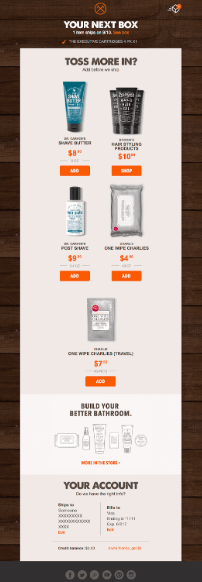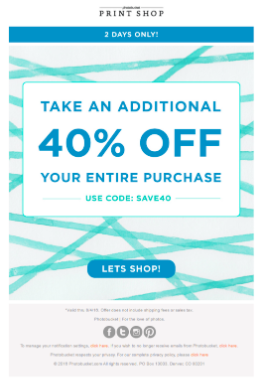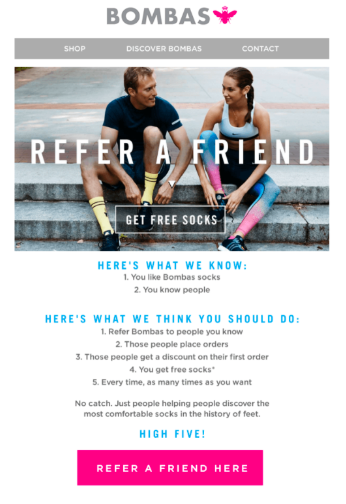How often do you wait for transactional emails like shipping confirmation emails, order confirmation emails, POS receipts after you’ve made a purchase?
Not surprisingly, many shoppers want to receive details about their transactions.
Baker Good Child reports that 95% of consumers read transactional mail while only 4% will discard it without reading. They also spend about 15 to 20 seconds to read each email.
How To Promote Your Products
Thanks to its high open rates, and captive audience many marketers have seen transactional emails as an opportunity to upsell their products. They’ve included product recommendations, discounts, and referral codes — to persuade users to make another purchase.
How can your business drive repeat purchases through transactional emails?
Here’s what you need to know.
1. Product Recommendations Within Emails
We’ve seen product recommendations in lots of emails, but how effective are they?
Barilliance conducted a study on how personalized product recommendations can increase AOV (average order value). Their researchers found that a session without recommendations cost around $44.41 — but this number increased by 369% once customers engaged with a recommendation.

Consumers love personalized product recommendations that SmartMail reports it can increase CTR by 300% or more. Once customers see recommendations that are based on their interests, they’ll most likely make a purchase.
This metric is just as effective post-purchase as it is at driving the purchase which triggered the order confirmation itself.
For example, the Dollar Shave Club delivers a set of product recommendations in their order confirmation emails. They feature items that customers can add to their cart for their next purchase, with the transaction details placed at the bottom. Allowing merchants to increase their CLTV (customer lifetime value) and with Shopify’s effort towards releasing the Order Editing API, merchants will be able to see an increase in order value, as their customers can respond to recommendations in real-time.

2. Coupons & Discounts
Should you give coupons and discounts to consumers? While selling with discounts can reduce your profit margins, it can increase sales and impact purchase decisions.
ReadyCloud found that emails with coupons have a 14% higher open rate, a 34% higher unique click rate, and a 27% higher transaction completion rate as compared to those without coupons or promo codes. In addition, emails with coupons lead to a 48% increase in revenue per email.
A coupon or discount is hard to pass up that’s why consumer revisit your website or return to your email. Sometimes they even add more items to the cart after they receive a coupon.
Printshop offers customers a 40% discount for their next purchase. The offer is valid for 2 days so customers are tempted to buy as soon as possible.

Next-purchase coupons or discount codes can significantly increase customer retention. In the long-term, it will enable customers to develop a habit of returning to the online store which eventually leads to brand loyalty.
3. Navigation Bar
Marketing experts put a lot of emphasis on the CTA button which readers click to view a website or landing page, but a navigation bar is just as pivotal.
A simple navigation bar with 3 to 4 categories can entice users to return to the online store. It also enables them to choose where they will be redirected (and you control that.)
Bombas’ referral email has a navigation menu with categories such as “Shop”, “Discover Bombas” and “Contact”. They’re evenly spaced and apart which makes it easy for mobile users to click the page that they want to visit.

You can even customize the navigation bar to complement your brand’s aesthetic. For instance, Bombas’ logo and navigation bar uses the color gray which matches with the brand’s logo. It’s also simple yet noticeable.
4. Referral Codes
It’s humbling when customers promote your brand within their circle.
Although referrals can take place by chance, it won’t hurt to incentive customers to recommend your products. Research found that consumers are 4 times more likely to buy when referred by a friend. According to the Wharton School of Business, the lifetime value of a referred customer is 25% higher than that of other customers.
It’s no surprise that we trust our family and friends more as compared to sponsored ads. They know us personally and they recommend based from experience.
Postmates, a brand that delivers groceries and alcohol, has a referral coupon at the bottom of their order confirmation email. The black and white box is very hard to miss — and an exciting offer for consumers looking to save on their next purchase.
Boost Sales Through Transactional Emails
Increasing sales through transactional email is as simple as described above, depending on your niche, or industry — all it takes is a bit of experimentation, to find out optimal locations (based on the customers journey) for discounts, recommendations, or referrals.
Here’s a quick recap. Remember to use product recommendations that make it either for customers to find the products that they’re interested in. Include next-purchase discount codes in emails so that customers can spot products that they want to buy.
Encourage customers to promote your brand through referral offers and generously reward them for a new customer. Add navigation bars that are consistent with your brand’s aesthetic.
What is your strategy to improve your transactional emails? How will you boost sales? Let us know in the comments below.
Oh! And if you’re on Shopify, take a look at Spently. We’ve got a neat little builder that allows you to drag-and-drop elements to curate custom, and branded store emails.
Author bio
Sal manages Product & Growth at Spently. Their application allows Shopify merchants to leverage their store emails as an additional sales channel by embedding marketing components to cultivate engagement, and queue follow up sequences to foster customer retention.
